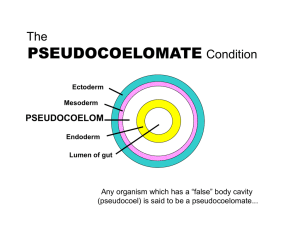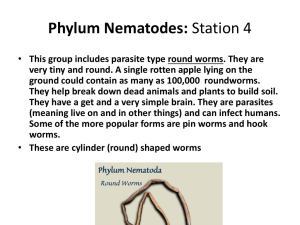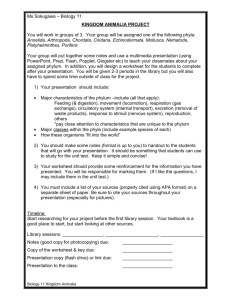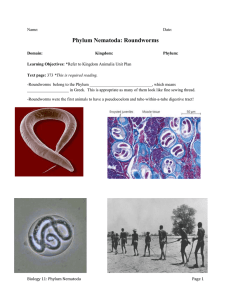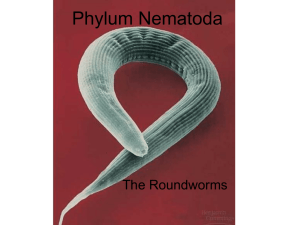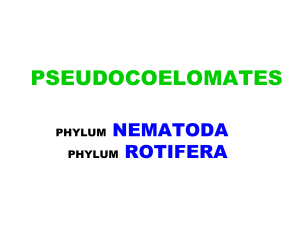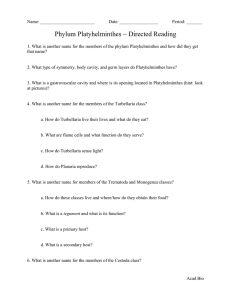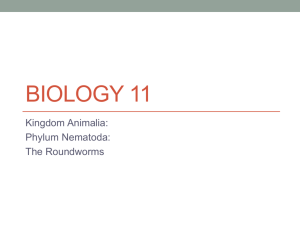Demonstration Sheets for Nematodes (Lab 4) Phylum Nematoda %
advertisement
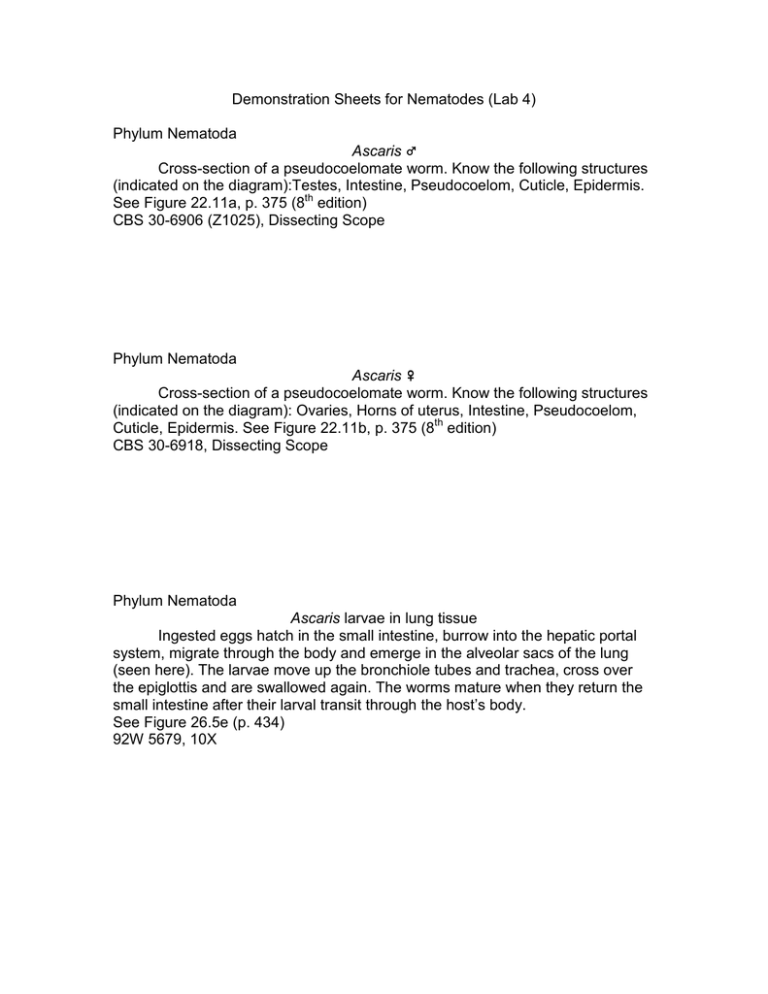
Demonstration Sheets for Nematodes (Lab 4) Phylum Nematoda Ascaris % Cross-section of a pseudocoelomate worm. Know the following structures (indicated on the diagram):Testes, Intestine, Pseudocoelom, Cuticle, Epidermis. See Figure 22.11a, p. 375 (8th edition) CBS 30-6906 (Z1025), Dissecting Scope Phylum Nematoda Ascaris & Cross-section of a pseudocoelomate worm. Know the following structures (indicated on the diagram): Ovaries, Horns of uterus, Intestine, Pseudocoelom, Cuticle, Epidermis. See Figure 22.11b, p. 375 (8th edition) CBS 30-6918, Dissecting Scope Phylum Nematoda Ascaris larvae in lung tissue Ingested eggs hatch in the small intestine, burrow into the hepatic portal system, migrate through the body and emerge in the alveolar sacs of the lung (seen here). The larvae move up the bronchiole tubes and trachea, cross over the epiglottis and are swallowed again. The worms mature when they return the small intestine after their larval transit through the host’s body. See Figure 26.5e (p. 434) 92W 5679, 10X Phylum Nematoda Ascaris lumbricoides adults This species is the largest nematode that lives in the intestinal lumen of humans. It is estimated that approximately ¼ of people world-wide are infected with these worms. Transmission occurs through oral consumption of the eggs by fecal contamination. Specimens No Scope Phylum Nematoda, Order Trichurida, Family Trichuridae Trichuris trichiura Whipworm Prevalence of this worm in children in some regions of the southeastern US has been measured between 20-25%. See Figure. 23.1, p. 400 (8th edition) Carolina 30-7050 & specimen in bottle Dissecting Scope Phylum Nematoda, Order Trichurida, Family Trichuridae Trichuris trichiura Ovum Egg with characteristic blunt ends. See Figure. 23.2, p. 400 (8th edition). Wards 92W 5793, 10X Phylum Nematoda, Order Trichurida, Family Trichuridae Trichinella spiralis Skeletal muscle (diaphragm) of mouse infected with encysted J3 larvae. The worms invade host muscle cells that then lose their myofilaments and become nurse cells. The nurse cells secrete collagen around the worm and a network of host blood vessels nourishes the cysts. See Figures 23.11 and 23.12, p. 406 (8th edition) Wards 92W 5764, 10X Phylum Nematoda, Order Trichurida, Family Trichuridae Trichinella spiralis Larval worms are embedded inside vertebrate host striated muscle cells (skeletal and cardiac). This is a worm that is an INTRACELLULAR parasite at this stage of development. Humans are usually infected by eating infected, uncooked pork, but uncooked meat from any predator (e.g. bear meat) is a potential source of infection. See Figures 23.11 and 23.12, p. 406 (8th edition) Triarch ZE 4-13, 4X Phylum Nematoda, Order Trichurida, Family Trichuridae Trichinella spiralis Migratory larvae These larvae are transported by lymph vessels to striated muscle where they encapsulate within muscle cells. PS 2445, 40X Phylum Nematoda, Order Rhabditida Strongyloides stercoralis Common in puppies from kennels with poor sanitation. People with suppressed immune systems are at risk of infection. Adults can be both freeliving and parasitic. Wards 92W 5741, 10X Phylum Nematoda, Order Strongylida, Family Ancyclostomidae Necator americanus Male and female hookworms. The COPULATORY BURSA is present on males only. Necator possesses flat plate-like teeth to hold on to host villi while Ancylostoma possesses fang-like pointed teeth. (Compare with adjacent slide.)Females are larger than males. See Figure 25.7, p. 422 (8th edition) 7-40, 4X Phylum Nematoda, Order Strongylida, Family Ancyclostomidae Ancylostoma duodenale The Ancylostoma mouth possesses characteristic prominent teeth rather than plates as in Necator. See Figure 25.8, p. 423 (8th edition) and compare with Necator slide on adjacent microscope. 17-38, 40X Phylum Nematoda, Order Strongylida, Family Ancyclostomidae Necator americanus Infective FILARIFORM J3 larvae. The usual method of infection is by burrowing into people’s feet. The esophagus does NOT have a bulb. See Figure 24.2i, p. 415 (8th edition) and compare with Figure 24.1. 2-42, 10X Phylum Nematoda, Class Rhabditea VISCERAL & CUTANEOUS LARVAL MIGRANS These nematodes were taken from the skin and the connective tissues surrounding the internal organs of a feral cat. Notice the transparent SHEATH that protects the worms from the host’s immune system. Specimens, Dissecting scope Three displays of nematodes taken from the stomachs of deer, hammerhead shark and alligator. (You will not be held responsible for knowing which of these examples was taken from what host.)
